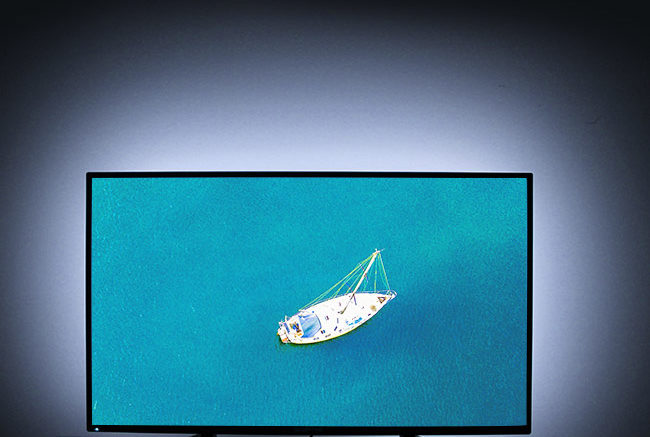For years, this blog has been singing the praises of bias lighting. Bias lighting is a way to improve your viewing experience by putting a light source behind your TV. It may seem like it doesn’t make sense, but bias lighting helps your eyes properly adjust and gives you the best possible experience in darkened rooms. Solid Signal has a bias light kit that installs easily on any TV and makes things just work better.
I talked about bias lighting as recently as a year ago on this blog. But in the year since, there’s been a new crop of HDR-capable, Dolby Vision-certified TVs to enter the lower end of the market. Once the province of TVs costing $2,000 or more, HDR and Dolby Vision unlock the potential of your TV by giving the ability to show more colors and translate those colors into something your TV is capable of showing.
Does that mean a bias light just isn’t necessary? There are two schools of thought here. Let’s take a look at both, and then in the end you can make your own decision.
The argument for “YES”
A lot of folks would argue that yes, you do need a bias light system for an HDR or Dolby Vision certified TV. They would argue that just having those features doesn’t eliminate the need for bias lighting. In order to understand the “Yes” argument, you need to understand what bias lighting does for you.
Your eyes are wonderful things, but they aren’t as capable as you think they are, especially as you age. Your eyes can take in very bright light, and they can also see in very dark environments. However, they can’t do both at the same time. If you watch a very bright TV in a very dark room, two things are going to happen. First, you’ll likely get a headache. The muscles that control your eyes get tired easily. They’re not designed to go from dark to light to dark over and over again that quickly. The second thing likely to happen is that depending on where your focus lies, you’ll either see too much of the darkness or too much of the light.
In other words, the screen may seem bright and washed out, or the room around you may totally disappear. Neither is really a perfect solution. By adding a bias light, it raises the amount of light in the room just a little bit. Your eyes never try to adapt for full darkness. This means your TV picture won’t seem washed out and you won’t break your toe on the coffee table you didn’t see in front of you. (Voice of experience here, folks.)
The argument for “NO”
Folks who say you don’t need a bias light will point out that HDR and Dolby Vision TVs are designed to operate in dim viewing environments. Generally, a properly calibrated image will be a little dimmer in most scenes, reserving the super bright light for moments of daylight or special effects. This is more like how life is. In most cases, the picture can seem too dim in bright light. The people who calibrate the TVs for HDR and Dolby Vision generally assume that your TV will be watched in conditions like a real movie theater. (They’re often wrong about that, but that’s a subject for another article.)
The people on this side say that a bias light can make the room too light and therefor blind your eyes to subtle details in the shadows. Since the whole purpose of HDR and Dolby Vision is to help you see more details in very dark and very light areas, they’ll say that adding a bias light actually makes viewing worse.
My take on the whole thing
I try to be pretty consistent here. I say, it’s your TV and you should watch it the way that looks better to you. My advice is to buy the bias light kit — it’s pretty cheap anyway — and try it out. Don’t attach it permanently to the back of the TV. Just put it back there with some masking tape temporarily. Then, watch a favorite HDR or Dolby Vision program that you know well. (For me, that’s Star Trek: The Motion Picture, Director’s Edition. Surprised?) Watch the same scene with and without the bias light, with a break of 10-15 minutes in the middle to let your eyes rest. If you think it looks better with the bias light, keep it. It’s as simple as that.
When it all comes down to it, it’s your TV and your living room. It’s your stuff that you paid for. It’s your eyes that watch it all and your brain that enjoys it. Don’t let some calibrator tell you that “the reference viewer’s point of view” is more important than yours. Here’s a secret: “the reference viewer” is a made up thing and you’re a real person. Which do you think should be more important?
TV Accessories and Common Sense from Solid Signal
Solid Signal is your source for everything you need to live your best digital life. We have tens of thousands of accessories from $5 to $50,000 depending on your need. We also have the best free tech support. Call before, during, and after the sale if you have questions. The number is 888-233-7563 and we’re here during East Coast business hours. If it’s after hours, fill out the form below. We’ll get back to you, usually within one business day.





